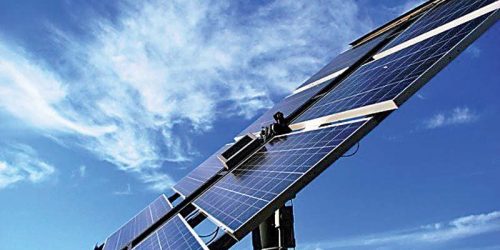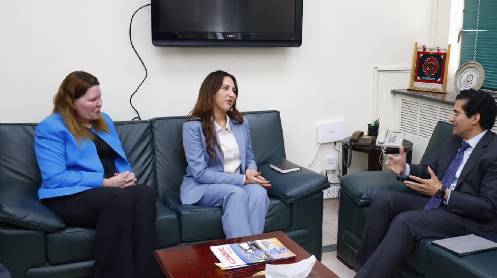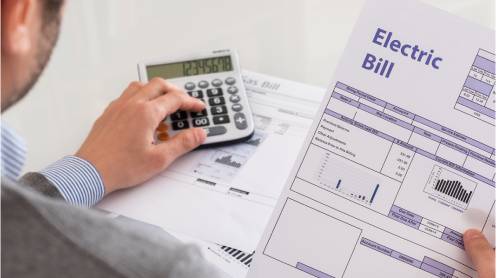Not far away is a solar panel powering the small appliance that is indispensable for many in summer. Solar panels, each with a cost of about Rs120,000, are more commonly seen in
his village.
“Many households in our village have solar panel, especially for air conditioning in summer. As more Chinese companies are providing solar panels to Pakistan, the problem of electricity shortage is greatly alleviated,” he told China Economic Net (CEN).
In Pakistan, the insufficiency of power, which leads to surging electricity tariff and foreign exchange expenditure on imported energy, is underscoring the necessity to be more self-sufficient in power generation.
Currently, thermal power still takes the bulk in Pakistan’s energy mix, accounting for 59% of the total installed capacity.
“Importing the fuel on which most of our power plants run has put a heavy burden on our treasury. That is why we have been thinking for a long time that we should focus on the assets that are being produced in our country,” Musadik Masood Malik, Minister of State (Petroleum Division) said in an interview with CEN.
“If solar is installed on every roof, those who suffer from heat and load-shedding can generate their own electricity at least all day, and if some surplus electricity is generated, they can sell it to the grid. They can also support their children and serve elderly parents,” the state minister said.
As a renewable energy source without fuel requirements, solar PV is significantly cost effective when compared to imported energy, RLNG, and gas.
According to the World Bank, Pakistan requires only 0.071% of its total land area (mainly in Balochistan) to achieve the benefits of solar power. If this potential is utilised, all of current energy needs can be met with solar power alone.
Leapfrogging development
An increasing number of companies and organisations are catching up as shown by the robust growth trend of Pakistan’s solar consumption.
As of March 2022, the Alternative Energy Development Board (AEDB)-certified solar system installers grew around 56%. Net metering based solar installations and power generation grew 102% and 108% respectively.
According to KASB analysis, it represents both government support and consumer demand and supply.
“Since late 2016, solar panels have been installed in 10,700 schools in Punjab and more than 2,000 in Khyber-Pakhtunkhwa. Punjab schools that were fitted with solar power collectively save around Rs509 million ($2.5 million) annually, which represents savings of around Rs47,500 ($237.5) on a per school basis annually,” a KASB analyst told CEN.
“Currently, the installation of solar panels in 4,200 schools in Punjab and over 6,000 schools in Khyber-Pakhtunkhwa is in progress,” the analyst said.
As per the Indicative Generation Capacity Expansion Plan (IGCEP), in May 2021, the imported coal accounted for 11% of the total installed generation capacity, RLNG (re-gasified liquefied natural gas) accounted for 17%, whereas solar accounted for only around 1%.
It is expected that the reliance on solar energy will increase to 13% and the reliance on imported coal and RLNG is expected to decrease to 8% and 11% respectively.
Close cooperation
Currently, out of the $144 million foreign investment in PV plants of Pakistan, $125 million is from China, accounting for nearly 87% of the total.
Among the 530-megawatt cumulative generation capacity in Pakistan, 400MW (75%) is generated from the Quaid-e-Azam Solar Park, the first-ever power plant capable of generating solar energy in the country, owned by the Punjab government and built by China’s Tebian Electric Apparatus Xinjiang New Energy Co.
With 400,000 solar panels spreading over 200 hectares of flat desert, the plant was initially launched with a capacity of generating 100MW.
Since 2015, there have been addition of 300MW power generation capacity with three new projects, and there are numerous planned projects reported for the Quaid-e-Azam Solar Park by AEDB with cumulative capacity of 1,050MW.
Chinese companies are also major suppliers to many PV projects such as mini-solar grids in Khyber-Pakhtunkhwa and ADB’s Access to Clean Energy Programme.
The solar mini-grid stations in Jandola, Orakzai and Mohmand tribal districts are in final stages of completion and soon the business community will get uninterrupted, cheap, green and
clean energy.
Pakistan’s solar energy market is expected to record a compound annual growth rate (CAGR) of 2.5% from 2022 to 2027.
Until now, the average utilisation rate of the operational solar PV plants is merely 19%, far from the over 95% utilisation rate in China, representing huge opportunities to be tapped.
As experienced PV plant investors in Pakistan, Chinese companies are more likely to further leverage their learning in the solar industry. They can also benefit from China’s pledge to move away from coal-based energy generation and promote green energy in developing countries.
Meanwhile, Pakistani government has set ambitious targets for solar PV capacity under the Integrated Generation Capacity Expansion Plan (IGCEP) of 2021.





